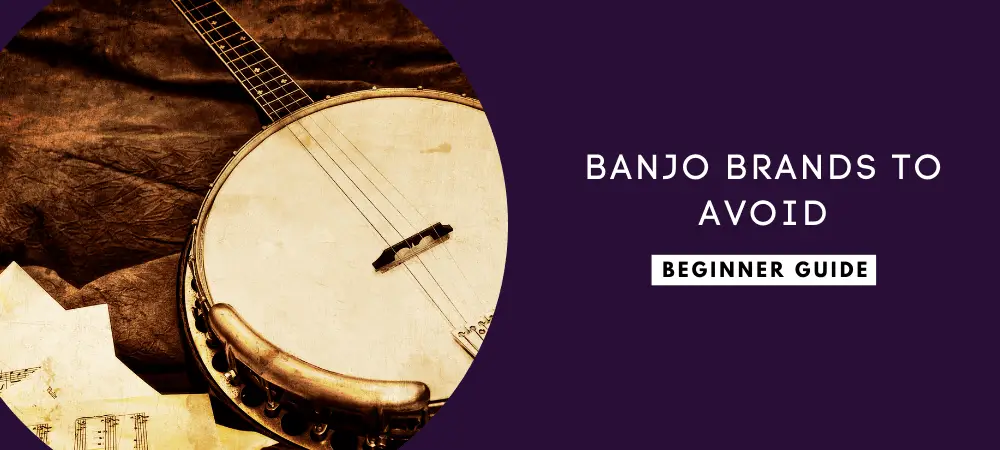One school of thought is that there aren’t any bad banjo brands. Instead, players tend to have different preferences and prejudices regarding a banjo’s sound, quality, and capabilities.
While that may be true, it is not entirely so. Bad banjo brands do exist, and this is evident in how their instruments play, how they sound, and pretty much simply how they feel in the player’s hands.
The challenging dilemma is how can you tell which banjo brands to avoid?
Table of Contents
What Banjo Brands To Avoid
Generally, a bad banjo brand fails to satisfy the player’s needs in one way or another.
What happens, therefore, is that the bad banjo ends up giving the user a terrible banjo experience.
Not only would this deter a person from playing the banjo, but it would also discourage them from learning the instrument altogether, especially if this was their first banjo.
This resourceful guide will make it easy for you to identify the banjo brands to avoid.
Bad Reputation
If a brand has a bad reputation in the market, then it goes without saying that you should steer clear of its banjos.
A bad reputation could come in the form of negative reviews. If many users seem to agree on the fact that a particular brand produces banjos that just aren’t good enough, then there you have it.
Coupled with positive reviews, a good reputation shows reliability, meaning you’d be putting your money to good use.
Fraudulent Website
There are many fraudulent sites in the banjo market waiting to scam you of your hard-earned money. So, be very cautious when dealing with a brand you may not have heard of before.
If the information provided on their website is insufficient or simply doesn’t add up, don’t go ahead to make the purchase.
Insufficient Customer Support
The best banjo brands have top-notch customer support, and the reverse applies to bad banjo brands.
One red flag to look out for is if a brand has insufficient information on their website, or maybe even their website is inexistent altogether.
If their customer support fails to address your queries efficiently, steer clear of their banjos.
Another thing to look out for is, does the banjo brand have a department for maintenance?
Should anything happen to your banjo, you’d be better off having it fixed by the people that manufactured it.
No Warranty
A reliable banjo brand, be it well-known or not, will include a warranty period for their banjos.
This period is usually 5 or 6 years, and it caters to any repairs or maintenance your banjo might need.
Even if you might end up not using it, a warranty guarantees peace of mind, and it is also proof that the manufacturer is confident in the quality of their instruments.
Cheap Prices
All buyers hope to make a sound purchase that will save them money without compromising the quality and value of their stringed instruments.
However, one thing to note is that if the price tag seems too good to be true, it most likely is.
A cheap banjo will likely compromise on craftsmanship and will be made from low-quality materials. All this will, in turn, impact the instrument’s intonation.
At the same time, how long do you think a banjo that’s poorly constructed will last?
In the long run, you will have to replace it much sooner than you had anticipated, which beats the whole point because you may as well have gotten a quality banjo for the cost of two cheap banjos.
The best banjo brands will offer value for money, such that you get a pretty affordable instrument while still standing out in quality.
Inferior Construction
A great banjo features excellent build and design, and this is the kind of instrument that will last you years to come, which is just what you want in a stringed instrument.
At the same time, a well-constructed banjo guarantees an instrument that you can hold comfortably and play with relative ease.
The same cannot be said of poorly manufactured banjos.
The instrument’s pitch and intonation are other aspects that could be affected by the craftsmanship of the banjo and the materials used to construct it.
For instance, maple rims produce higher quality sound than cheaper rims constructed from softer woods.
Another thing to note is that the best banjos are constructed from wood that is strong but not heavy. Strong wood is more resistant to wear and tear, thereby ensuring the durability of the instrument.
Consequently, poor quality banjo brands make their instruments from dense wood.
The disadvantage here is that the dense wood will result in a heavy banjo that’s difficult to hold and maneuver, thereby giving you an instrument that’s difficult to play or even not playable at all.
Now, why would you want to end up with a banjo you can hardly play?
Limiting Features
Great banjo brands will manufacture a variety of instruments to cater to players of different proficiency levels.
A beginner banjo will not necessarily meet the needs and expectations of professional banjo players and vice versa.
This is another crucial aspect to consider because decent banjo brands incorporate at least the basic features on all their instruments, more so those designed for beginner banjo players.
The idea here is that whichever banjo you go for should meet your requirements and expectations as a banjo player.
These expectations may be about the sound produced, the instrument’s tone, or even its playability.
If you find that your banjo brand has awful action and is even hard to fret, then that’s a problem.
At the same time, does the stringed instrument have powerful volume, or do you find it too quiet, thereby limiting where and how you can play it?
Limitations can come in a variety of aspects. Ultimately, this is more of a preference or prejudice rather than an overall indicator of bad banjo brands to avoid.
If the banjo doesn’t accomplish what you expect of it, then that’s a limitation. Meaning you should steer clear of that particular brand because it will cripple your playing abilities.
The best banjos should satisfy your needs, providing a pleasant tone while still being comfortable to hold and play.
Once you have played several available banjos and compared brands, you will find out what you consider a limitation on your end. Likewise, you will better understand what you are looking for in a banjo brand.
Poor Quality Components
It is possible to modify specific components on a banjo after purchase, especially if you are dealing with a used instrument. You can alter a banjo’s action, bridge, tuning pegs, resonator, etc., with better quality parts.
However, keep in mind that the cost of these modifications would amount to the price of a new banjo from a reputable brand.
Best Banjo Brands That We Recommend
- Deering – Deering Goodtime 2 5-String Banjo
- Ibanez – Ibanez B50 5-String Banjo
- Oscar Schmidt – Oscar Schmidt OB5SP 5-String Banjo
- Recording King – Recording King RK-OT25-BR Madison Open Back Banjo
- Kmise – Kmise 5-String Banjo Full Size
What Makes A Bad Banjo And What To Look For
How the best banjo is supposed to work is that first, the strings are plucked. When plucked, the strings vibrate the bridge, which then vibrates the banjo head, and consequently, the instrument’s body.
All these vibrations are what create the audible sound of a banjo. For this to happen, all components should be fitted firmly so they won’t shift out of place while playing.
At the same time, there shouldn’t be any movement between the banjo’s neck and body, nor should banjo players find the instrument hard to fret.
A bad banjo fails in one or more of these aspects, and this applies regardless of whether it is a new banjo or a used banjo.
Here are the components to look out for in a poor quality banjo:
Neck
The neck is an essential part of the banjo, and good banjo brands will use maple for the neck.
Ideally, the perfect neck should be narrow enough to be playable but not so slender that it can warp.
On a great instrument, the neck will have a steel reinforcement rod to guard against warping by keeping it straight and durable.
Achieving this takes a good deal of craftsmanship and quality control, which you are not likely to find on poorly manufactured banjo brands.
Here’s a fact that might surprise you: it is actually cheaper to make a fancy-looking banjo than it is to manufacture an excellent neck.
At the same time, a poor quality neck will affect the instrument’s intonation. This is because it would be hard for the player to press down on the strings, thereby limiting their ability to play notes that are in tune.
Tuning Pegs
Tuning pegs hold the strings in place, thereby preventing them from sliding wildly out of tune.
These pegs should be firmly fixed in place on a banjo. If the tuners move too freely, keeping the stringed instrument in tune will be impossible, thereby rendering it impossible to play.
Bridge
Banjos have a floating bridge that’s held in place by the tension of the strings. If the strings aren’t taut, the bridge will not vibrate accordingly when the instrument is played, thereby affecting tone and sound.
FAQs About Banjo Brands To Avoid
Is Gold Tone A Good Banjo
Yes, Gold Tone is a pretty decent banjo brand. Their banjos are famed for having lightweight instruments that are very affordably priced.
That being said, experienced banjo players may prefer a more advanced banjo that pays a little more attention to detail.
What Banjos Are Made In The USA?
Bishline, Selling, Deering, Huber, Yates, Osbourne, and Ome banjos are all made in the USA.
Of course, there are a wide variety of brands out there. These are just a few of the top banjo brands that make and assemble their instruments entirely in the USA.
What Is A Good Banjo Brand?
A good banjo brand is one that carefully and expertly incorporates a couple of variables, including:
- Affordability
- Durability
- Comfortable to play
- Easy to fret
- Premium quality
- Excellent build and design
- A warm, tuneful sound
- Powerful volume
- Stays in tune
Ultimately all banjo players are looking for a brand that’s reliable and trustworthy when it comes to the quality and durability of their instruments.
Conclusion
Good quality banjos are meant to last a lifetime. And if you make a sound investment, you will end up with a banjo brand that guarantees just that.
Whether you play bluegrass or clawhammer, good banjo brands will offer models that satisfy the needs of all players.
Avoid settling for less. You don’t have to buy an instrument with a hefty price tag, but don’t be too quick to buy a cheap banjo either.








![How Hard Is It to Play the Banjo? [ANSWERED]](https://musictechhub.com/wp-content/uploads/2020/04/How-Hard-Is-It-to-Play-the-Banjo-250x170.png)

